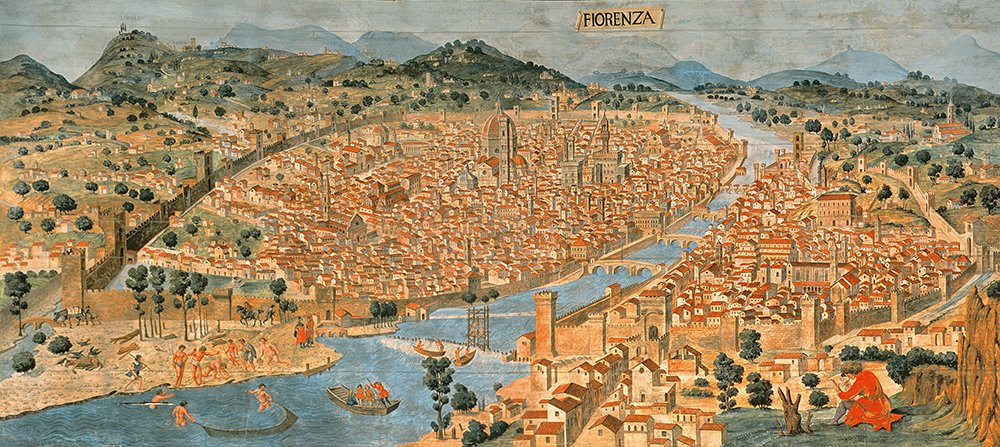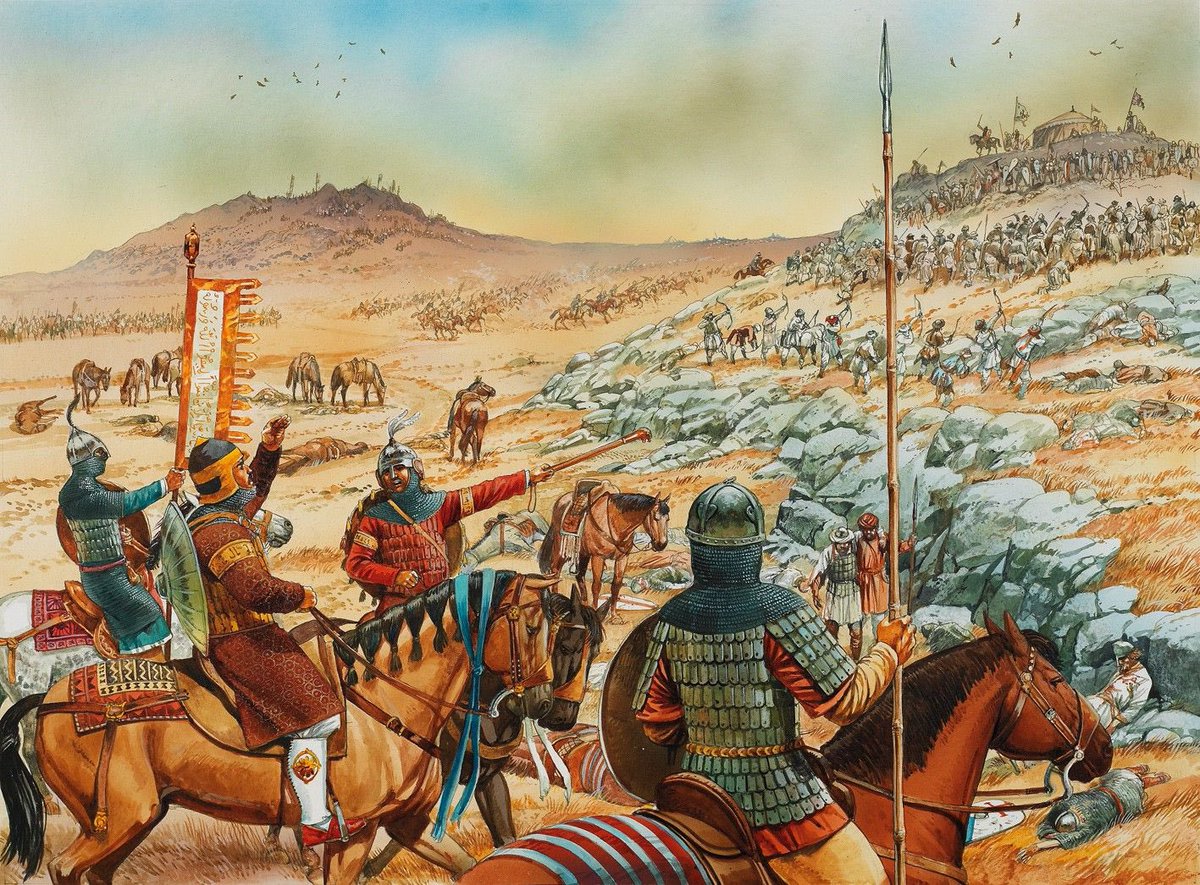
Luxury historical commentary.
Read 'Saladin the Strategist': https://t.co/kiWQBy63F2
Other books: https://t.co/rMfJ3koLAO
12 subscribers
How to get URL link on X (Twitter) App


 The industry that first made Florence rich was textiles. Tuscany as a whole had lots of resources that fed the industry: dyes like woad, saffron, and madder grew in the nearby hills, and alum, a fixative for dyes, was mined near the coast.
The industry that first made Florence rich was textiles. Tuscany as a whole had lots of resources that fed the industry: dyes like woad, saffron, and madder grew in the nearby hills, and alum, a fixative for dyes, was mined near the coast. 




 Silk was the quintessential luxury product from the East. Italian towns like Lucca began weaving silk cloth imported from the Levant in the 12th century, and by 1400 were exporting their finished products across Europe and back to the Eastern Mediterranean.
Silk was the quintessential luxury product from the East. Italian towns like Lucca began weaving silk cloth imported from the Levant in the 12th century, and by 1400 were exporting their finished products across Europe and back to the Eastern Mediterranean. 

https://twitter.com/byzantinemporia/status/1236740282072412161
 Anatolia was the Ottomans’ base of power, where they welded together the Turkic beyliks that formed in the wake of Byzantine retreat. This was a gradual process, and by the 15th c. several retained varying degrees of independence.
Anatolia was the Ottomans’ base of power, where they welded together the Turkic beyliks that formed in the wake of Byzantine retreat. This was a gradual process, and by the 15th c. several retained varying degrees of independence.https://x.com/byzantinemporia/status/1127566577040265219

https://x.com/byzantinemporia/status/1542219091477413888

 The Franks who expanded into Gaul in the 6th century were unique among the barbarian kingdoms of Western Europe. Their king Clovis converted to Nicene Christianity, aligning himself with the surviving elite of the post-Roman West.
The Franks who expanded into Gaul in the 6th century were unique among the barbarian kingdoms of Western Europe. Their king Clovis converted to Nicene Christianity, aligning himself with the surviving elite of the post-Roman West. 

 The flood of New World silver into Asian markets in the 1500s crushed the value of metal currency, but also supercharged trade as new markets were opened for exports. The effect was the same from Syria to China.
The flood of New World silver into Asian markets in the 1500s crushed the value of metal currency, but also supercharged trade as new markets were opened for exports. The effect was the same from Syria to China.https://twitter.com/byzantinemporia/status/1526666188910215168

https://twitter.com/DrLanternJack/status/1742288190344683817To start with, one thing he gets right is that the classical Greeks deprecated the value of individual skill at arms—if anything, that would detract from their willingness to hold the line. Here’s a wonderful passage from the Spartan poet Tyrtaeus, who is mentioned:


https://twitter.com/StilichoReads/status/1714085558660853980


 That's a staggering amount of material, intellectual, and economic infrastructure required just to sustain one part of a very complicated process. Sustaining that infrastructure depends in turn on maintaining the process. If any one of several highly-centralized nodes is disrupted for any length of time, it becomes disproportionately more expensive and difficult to get it back online.
That's a staggering amount of material, intellectual, and economic infrastructure required just to sustain one part of a very complicated process. Sustaining that infrastructure depends in turn on maintaining the process. If any one of several highly-centralized nodes is disrupted for any length of time, it becomes disproportionately more expensive and difficult to get it back online.

 The House of Lusignan founded the Kingdom in 1196 and ruled it for its three-century existence. They were of French origin, and attracted many knights and nobles from both France proper and the Crusader states.
The House of Lusignan founded the Kingdom in 1196 and ruled it for its three-century existence. They were of French origin, and attracted many knights and nobles from both France proper and the Crusader states.https://twitter.com/byzantinemporia/status/1618692796818554882


 As soon as Venice began acquiring her terra ferma empire in Italy, she found herself torn between obligations on the mainland and the rising Ottoman threat in the east. The great danger was that crises would flare up in both directions at once.
As soon as Venice began acquiring her terra ferma empire in Italy, she found herself torn between obligations on the mainland and the rising Ottoman threat in the east. The great danger was that crises would flare up in both directions at once.https://twitter.com/byzantinemporia/status/1663916403433381890

 The 1261 Treaty of Nymphaeum had already guaranteed Genoa extensive trade concessions in the empire in return for naval assistance against the Crusaders occupying Constantinople. As it turned out, the Byzantines recaptured Constantinople without needing this help.
The 1261 Treaty of Nymphaeum had already guaranteed Genoa extensive trade concessions in the empire in return for naval assistance against the Crusaders occupying Constantinople. As it turned out, the Byzantines recaptured Constantinople without needing this help. 


 There are four big factors:
There are four big factors:
 When Genoese, Venetian, and Pisan crews arrived in the Levant in the wake of the First Crusade, they quickly realized the fortunes to be made. They assisted the Crusaders in conquering cities along the coast in return for quarters that could be used as trade colonies.
When Genoese, Venetian, and Pisan crews arrived in the Levant in the wake of the First Crusade, they quickly realized the fortunes to be made. They assisted the Crusaders in conquering cities along the coast in return for quarters that could be used as trade colonies. 

 Banking ultimately came out of money-changing. Money-changers had always been around, earning a premium on the spread between exchange rates—this was necessary for interregional commerce.
Banking ultimately came out of money-changing. Money-changers had always been around, earning a premium on the spread between exchange rates—this was necessary for interregional commerce.

https://twitter.com/byzantinemporia/status/1682127111241322496

 William Montagu was among the oldest of the lot, 36 when the war broke out, and was the king’s closest advisor. He was sent to the Low Countries in 1337 to arrange an alliance with local princes.
William Montagu was among the oldest of the lot, 36 when the war broke out, and was the king’s closest advisor. He was sent to the Low Countries in 1337 to arrange an alliance with local princes.https://twitter.com/byzantinemporia/status/1682127743452954624


https://twitter.com/byzantinemporia/status/1500504467862691845
 By the summer of 1336, it was clear that France and England were headed for war. Tensions had been building for years over the Duchy of Aquitaine, a territory in southwest France held in fief by the English Crown.
By the summer of 1336, it was clear that France and England were headed for war. Tensions had been building for years over the Duchy of Aquitaine, a territory in southwest France held in fief by the English Crown. 


 There were three main routes to the Mediterranean from the Indian Ocean in antiquity:
There were three main routes to the Mediterranean from the Indian Ocean in antiquity:

https://twitter.com/byzantinemporia/status/1675984737729380352
 The Second Crusade was launched in response to the first great crisis that Outremer faced: the fall of Edessa to the powerful warlord Zengi. This brought the loss of much of their inland territories east of the defensible coastal ranges and the Jordan.
The Second Crusade was launched in response to the first great crisis that Outremer faced: the fall of Edessa to the powerful warlord Zengi. This brought the loss of much of their inland territories east of the defensible coastal ranges and the Jordan.https://twitter.com/byzantinemporia/status/1675985572815413251

https://twitter.com/byzantinemporia/status/1675606118905544705
 In the 4th century, an Egyptian Greek visited the island of Taprobane (usually identified as Sri Lanka, based on Ptolemy’s description). He reported that magnetic rocks on the island prevented ships made with iron nails from departing. https://t.co/WsdwqjNOsAtwitter.com/i/web/status/1…
In the 4th century, an Egyptian Greek visited the island of Taprobane (usually identified as Sri Lanka, based on Ptolemy’s description). He reported that magnetic rocks on the island prevented ships made with iron nails from departing. https://t.co/WsdwqjNOsAtwitter.com/i/web/status/1…

https://twitter.com/byzantinemporia/status/1675608935271653377
 Tang Dynasty expansion in the 7th century brought much of Central Asia under its protection, the farthest that Chinese authority had ever extended. This included the western desert routes through modern Xinjiang and the Sogdian cities of Transoxiana.
Tang Dynasty expansion in the 7th century brought much of Central Asia under its protection, the farthest that Chinese authority had ever extended. This included the western desert routes through modern Xinjiang and the Sogdian cities of Transoxiana. 

https://twitter.com/byzantinemporia/status/1675984737729380352
 The campaign of 1187 was Saladin’s fifth major invasion of the Kingdom of Jerusalem. He had greatly outnumbered the Crusaders on each previous occasion, but these had resulted in one major defeat, a minor victory, and two stalemates.
The campaign of 1187 was Saladin’s fifth major invasion of the Kingdom of Jerusalem. He had greatly outnumbered the Crusaders on each previous occasion, but these had resulted in one major defeat, a minor victory, and two stalemates.